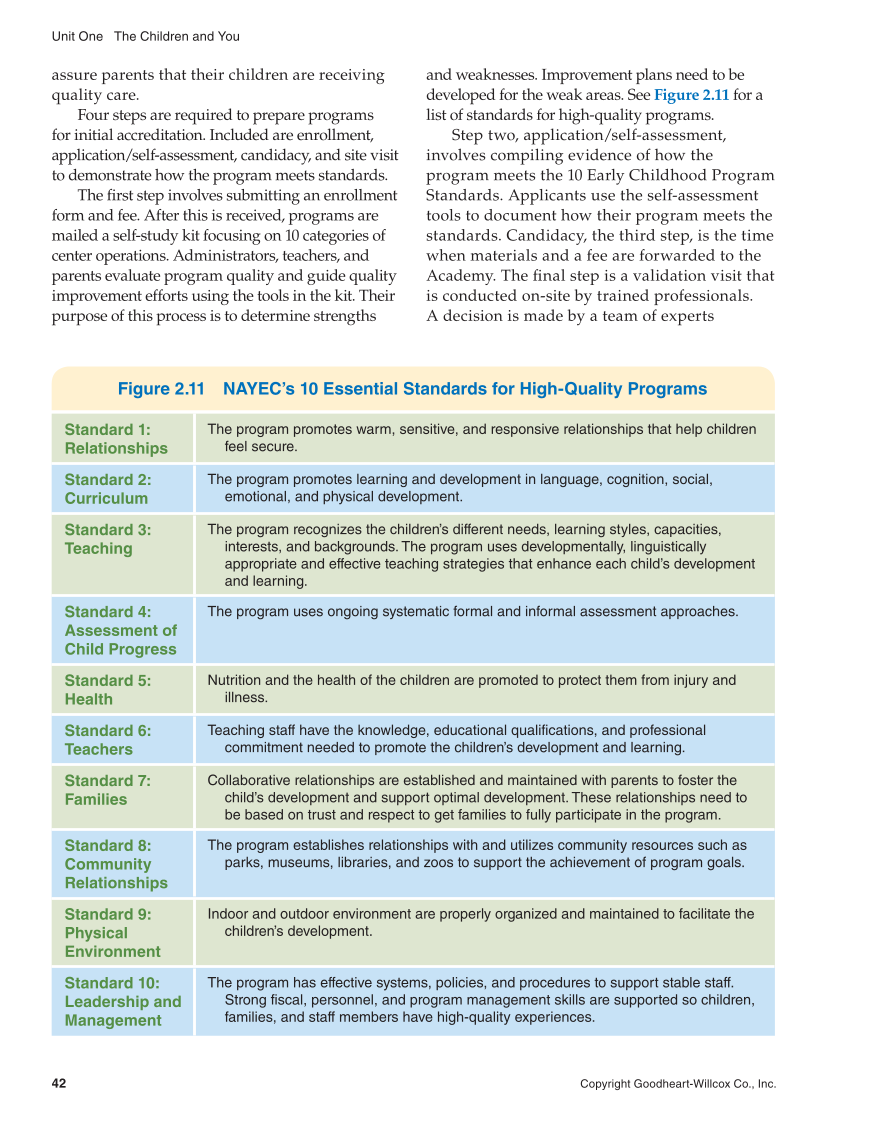Unit One The Children and You
42
Copyright Goodheart-Willcox Co., Inc.
assure parents that their children are receiving
quality care.
Four steps are required to prepare programs
for initial accreditation. Included are enrollment,
application/self-assessment, candidacy, and site visit
to demonstrate how the program meets standards.
The fi rst step involves submitting an enrollment
form and fee. After this is received, programs are
mailed a self-study kit focusing on 10 categories of
center operations. Administrators, teachers, and
parents evaluate program quality and guide quality
improvement efforts using the tools in the kit. Their
purpose of this process is to determine strengths
and weaknesses. Improvement plans need to be
developed for the weak areas. See Figure 2.11 for a
list of standards for high-quality programs.
Step two, application/self-assessment,
involves compiling evidence of how the
program meets the 10 Early Childhood Program
Standards. Applicants use the self-assessment
tools to document how their program meets the
standards. Candidacy, the third step, is the time
when materials and a fee are forwarded to the
Academy. The fi nal step is a validation visit that
is conducted on-site by trained professionals.
A decision is made by a team of experts
Figure 2.11 NAYEC’s 10 Essential Standards for High-Quality Programs
Standard 1:
Relationships
The program promotes warm, sensitive, and responsive relationships that help children
feel secure.
Standard 2:
Curriculum
The program promotes learning and development in language, cognition, social,
emotional, and physical development.
Standard 3:
Teaching
The program recognizes the children’s different needs, learning styles, capacities,
interests, and backgrounds. The program uses developmentally, linguistically
appropriate and effective teaching strategies that enhance each child’s development
and learning.
Standard 4:
Assessment of
Child Progress
The program uses ongoing systematic formal and informal assessment approaches.
Standard 5:
Health
Nutrition and the health of the children are promoted to protect them from injury and
illness.
Standard 6:
Teachers
Teaching staff have the knowledge, educational qualifications, and professional
commitment needed to promote the children’s development and learning.
Standard 7:
Families
Collaborative relationships are established and maintained with parents to foster the
child’s development and support optimal development. These relationships need to
be based on trust and respect to get families to fully participate in the program.
Standard 8:
Community
Relationships
The program establishes relationships with and utilizes community resources such as
parks, museums, libraries, and zoos to support the achievement of program goals.
Standard 9:
Physical
Environment
Indoor and outdoor environment are properly organized and maintained to facilitate the
children’s development.
Standard 10:
Leadership and
Management
The program has effective systems, policies, and procedures to support stable staff.
Strong fiscal, personnel, and program management skills are supported so children,
families, and staff members have high-quality experiences.
